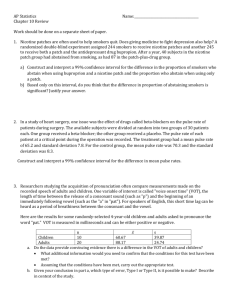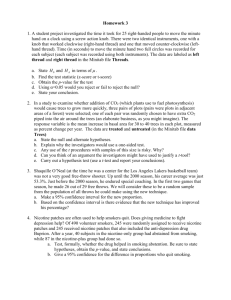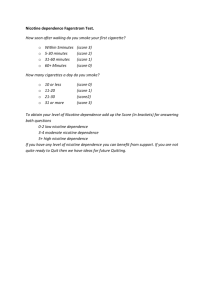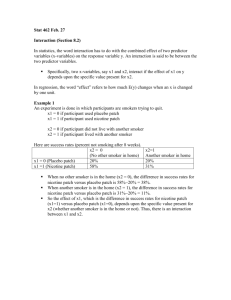Nicotine Transdermal Patch
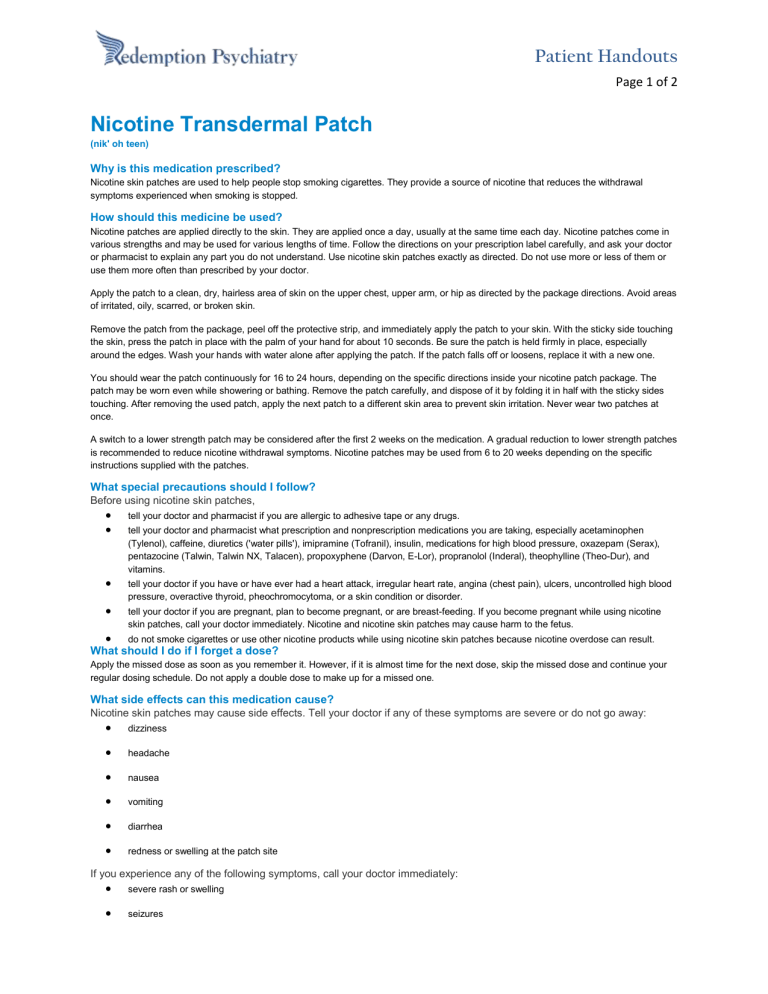
Patient Handouts
Page 1 of 2
Nicotine Transdermal Patch
(nik' oh teen)
Why is this medication prescribed?
Nicotine skin patches are used to help people stop smoking cigarettes. They provide a source of nicotine that reduces the withdrawal symptoms experienced when smoking is stopped.
How should this medicine be used?
Nicotine patches are applied directly to the skin. They are applied once a day, usually at the same time each day. Nicotine patches come in various strengths and may be used for various lengths of time. Follow the directions on your prescription label carefully, and ask your doctor or pharmacist to explain any part you do not understand. Use nicotine skin patches exactly as directed. Do not use more or less of them or use them more often than prescribed by your doctor.
Apply the patch to a clean, dry, hairless area of skin on the upper chest, upper arm, or hip as directed by the package directions. Avoid areas of irritated, oily, scarred, or broken skin.
Remove the patch from the package, peel off the protective strip, and immediately apply the patch to your skin. With the sticky side touching the skin, press the patch in place with the palm of your hand for about 10 seconds. Be sure the patch is held firmly in place, especially around the edges. Wash your hands with water alone after applying the patch. If the patch falls off or loosens, replace it with a new one.
You should wear the patch continuously for 16 to 24 hours, depending on the specific directions inside your nicotine patch package. The patch may be worn even while showering or bathing. Remove the patch carefully, and dispose of it by folding it in half with the sticky sides touching. After removing the used patch, apply the next patch to a different skin area to prevent skin irritation. Never wear two patches at once.
A switch to a lower strength patch may be considered after the first 2 weeks on the medication. A gradual reduction to lower strength patches is recommended to reduce nicotine withdrawal symptoms. Nicotine patches may be used from 6 to 20 weeks depending on the specific instructions supplied with the patches.
What special precautions should I follow?
Before using nicotine skin patches,
tell your doctor and pharmacist if you are allergic to adhesive tape or any drugs.
tell your doctor and pharmacist what prescription and nonprescription medications you are taking, especially acetaminophen
(Tylenol), caffeine, diuretics ('water pills'), imipramine (Tofranil), insulin, medications for high blood pressure, oxazepam (Serax), pentazocine (Talwin, Talwin NX, Talacen), propoxyphene (Darvon, E-Lor), propranolol (Inderal), theophylline (Theo-Dur), and vitamins.
tell your doctor if you have or have ever had a heart attack, irregular heart rate, angina (chest pain), ulcers, uncontrolled high blood pressure, overactive thyroid, pheochromocytoma, or a skin condition or disorder.
tell your doctor if you are pregnant, plan to become pregnant, or are breast-feeding. If you become pregnant while using nicotine skin patches, call your doctor immediately. Nicotine and nicotine skin patches may cause harm to the fetus.
do not smoke cigarettes or use other nicotine products while using nicotine skin patches because nicotine overdose can result.
What should I do if I forget a dose?
Apply the missed dose as soon as you remember it. However, if it is almost time for the next dose, skip the missed dose and continue your regular dosing schedule. Do not apply a double dose to make up for a missed one.
What side effects can this medication cause?
Nicotine skin patches may cause side effects. Tell your doctor if any of these symptoms are severe or do not go away:
dizziness
headache
nausea
vomiting
diarrhea
redness or swelling at the patch site
If you experience any of the following symptoms, call your doctor immediately:
severe rash or swelling
seizures
Patient Handouts
Page 2 of 2
abnormal heartbeat or rhythm
difficulty breathing
If you experience a serious side effect, you or your doctor may send a report to the Food and Drug Administration's (FDA) MedWatch
Adverse Event Reporting program online [at http://www.fda.gov/Safety/MedWatch ] or by phone [1-800-332-1088].
What should I know about storage and disposal of this medication?
Keep this medication in the container it came in, tightly closed, and out of reach of children. Store it at room temperature and away from excess heat and moisture (not in the bathroom). Throw away any medication that is outdated or no longer needed. Carefully throw away used patches by folding them with the sticky sides together and out of reach of children or pets.
In case of emergency/overdose
In case of overdose, call your local poison control center at 1-800-222-1222. If the victim has collapsed or is not breathing, call local emergency services at 911.
What other information should I know?
Keep all appointments with your doctor.
Do not let anyone else use your medication. Ask your pharmacist any questions you have about refilling your prescription.
It is important for you to keep a written list of all of the prescription and nonprescription (over-the-counter) medicines you are taking, as well as any products such as vitamins, minerals, or other dietary supplements. You should bring this list with you each time you visit a doctor or if you are admitted to a hospital. It is also important information to carry with you in case of emergencies.
Brand names
Nicoderm
®
CQ Patch
Nicotrol
®
Patch
